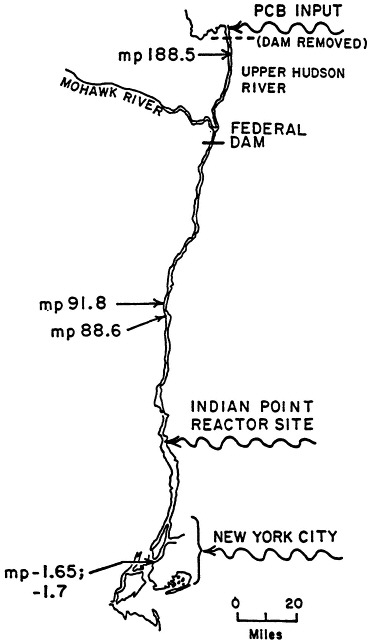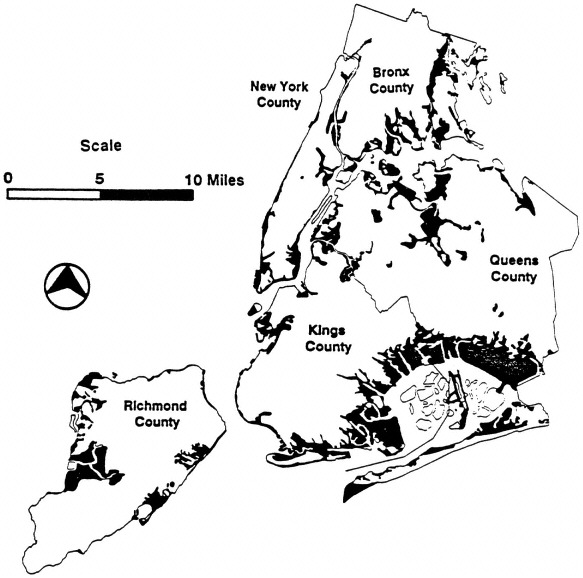5
Rivers and Estuaries: a Hudson Perspective
Richard F. Bopp, Daniel C. Walsh
Rensselaer Polytechnic Institute
Troy, New York
INTRODUCTION
The perspective of this paper and the specific examples used for illustration reflect the fact that the principal author has spent much of the past fifteen years involved in geochemical research on the Hudson River and contiguous waters. The general observations should be broadly applicable to rivers and estuaries and provide a basis for further discussion.
The initial announcement of the Coastal Zone Retreat proposed a goal of "approaching broad resource and environmental issues somewhat more holistically than our sometimes more piecemeal efforts". The Hudson is an excellent candidate for such coordination. Present federal research on the system includes a Superfund project to reassess the Polychlorobiophenyl (PCB) problem (Environmental Protection Agency); the New York-New Jersey Harbor Estuary Program (Environmental Protection Agency); involvement in the National Oceanic and Atmospheric Agency (NOAA) National Status and Trends Program; studies of its tidal marshes as part of the National Estuarine Sanctuaries Program (NOAA); and U.S. Geological Survey (USGS) studies as part of their National Water Quality Assessment Program. Additional research funds, on the order of a million dollars a year, are supplied by a private foundation, the Hudson River Foundation. State and city efforts, policy and regulatory considerations, and active participation of environmental groups such as Natural Resources Defense Council and Environmental Defense Fund add to the challenge of arriving at a holistic approach. It seems that a logical initial step in this direction involves a consideration of research needs and directions. Past experience on the Hudson suggests the following:
BASIC INFORMATION
Under this heading, we include freshwater discharge, salinity distributions, and suspended-matter concentrations. These parameters provide the primary constraints on hydrodynamic models and form the basis for our understanding of contaminant transport (Figure 5.1) and nutrient dynamics. For the

FIGURE 5.1 Cumulative percentage of PCB, suspended matter, and water transport from the upper Hudson for the ten days of highest suspended-matter concentration for the period from March 1, 1983 through September 30, 1983. Flow and suspended matter concentration data were from the USGS monitoring station atStillwater, NY (USGS, 1984). PCB measurements and transport calculations were from Bopp et al. (1985). This plot emphasizes the importance of high-flow events in particle and associated contaminant transport.
Hudson, our concern focuses on the latter two parameters. To our knowledge, there is no continuous, long-term salinity-monitoring data for the Hudson estuary prior to 1987 when the USGS established two stations. The USGS has monitored suspended-matter concentrations daily since 1977 at the two stations, both located above the first dam on the river (Figure 5.2). Estimates of transport of suspended particles in the tidal Hudson basin generally refer to a data set collected at a single station during the 1960 water year Panuzio, 1965 and to limited data sets of Arnold (1982), Suszkowski (1978), the Institute for Ecosystem Studies (Findlay, 1991), and the Lamont-Doherty Geological Observatory (Olsen, 1979).
Continuous measurements of salinity (conductivity) and suspended particle concentrations (turbidity) are now fairly routine in oceanographic studies. Increased application of this type of monitoring in rivers and estuaries should be pursued.
TRENDS AND THE CURRENT SITUATION
Particle-Associated Contaminant Levels
A useful tool for studying trends in particle-associated contaminant levels is the analysis of dated sediment core sections (Alderton, 1985). Depositional timescales are generally determined from the depth distributions of natural (Pb-210, Be-7) and anthropogenic (Cs-137, Pu-239,240) radionuclides. Among the earliest applications of this technique to estuaries is the work of Goldberg on trace metal pollution (Goldberg, 1976; Goldberg et al., 1977, 1978, 1979). Continued and expanded use of this technique is a major emphasis of NOAA's National Status & Trends Program.
In the Hudson, analyses of dated sediment cores have helped to define the response time of the system to pollution events (Figure 5.3), to assess the contribution of contaminants from New York Metropolitan Area sewage treatment plants, and to quantify the improvements in levels of chlorinated hydrocarbons that were banned in the 1970s (Figure 5.4) (Bopp et al., 1982; Bopp and Simpson, 1989).
Recently, studies utilizing dated sediment core samples have expanded in scope, both in terms of the number of contaminants analyzed and the number of rivers and estuarine systems studied. We believe that this is a very positive development that should be encouraged. We strongly suggest that, in addition to time-trend analysis, other aspects of this technique should be pursued. For example:
The geographic distribution of current levels of particle-associated contaminants can be established through analysis of near-surface sediments in areas of rapid deposition. Such areas can be identified through measurements of the short-lived, particle-associated radionuclides such as Be-7 (t1/2=53.4 days). Gram-sized samples of current particles suitable for contaminant analyses can also be collected by large-volume in situ filtration (Bishop et al., 1985), a technique developed for oceanographic studies that should be much more widely applied to river and estuarine systems.
Such studies can help to identify major point sources of contaminants (Figure 5.5) and provide an indication of the scale of particle and associated contaminant mixing and transport (Table 5.1).
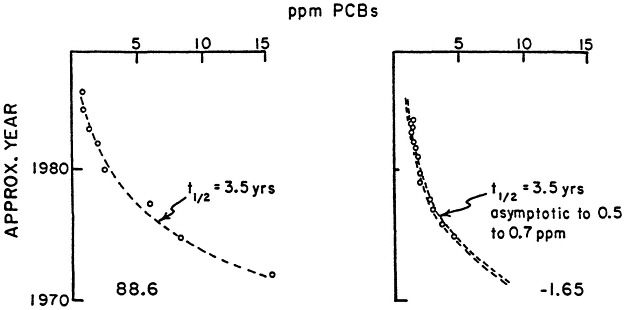
FIGURE 5.3 Data from dated cores from the Hudson River showing a dramatic decline in PCB levels in sediments deposited between the mid 1970's and the late 1980's. The data were discussed in greater detail. (Source: Bopp and Simpson, 1989)
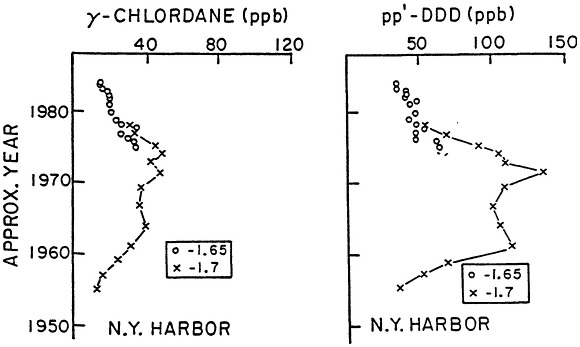
FIGURE 5.4 Chronologies of chlordane and DDT-derived compound levels accumulating in New York Harbor. (Source: Bopp and Simpson, 1989)
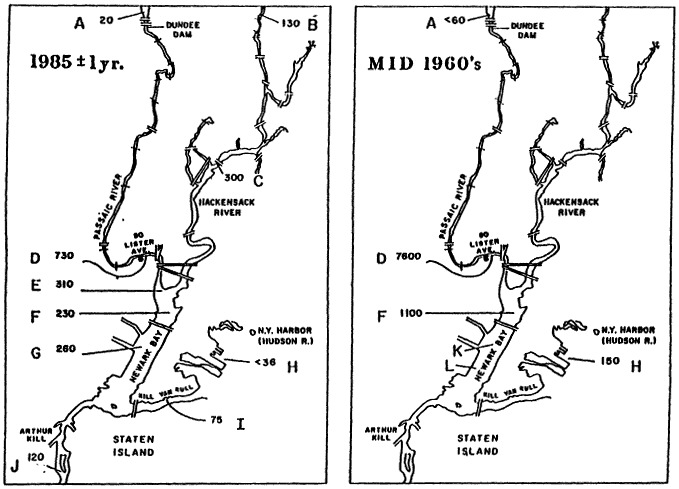
FIGURE 5.5 Levels of 2,3,7,8-TCDD (parts per trillion) on particulars from two horizons from Newark Bay and contiguous water. The 1985 ±1 year samples were suspended matter (sites G & J) and core top samplesfrom areas of rapid deposition characterized by significant activity of the short-lived radionuclide, Be-7. The mid-1960s time horizon samples were chosen based on the depth profile of the fallout radionuclide, Cs-137. The data are consistent with a major source of 2,3,7,8-TCDD from a chemical manufacturing facility at 80 Lister Avenue on the lower Passaic River. (Source: Bopp et al., 1991a) Reprinted with permission from American Society, 1991.
TABLE 5.1 Levels of chlorinated hydrocarbons on particles from two time horizons from New York Harbor. The two sets of samples were core tops collected during 1982-84 and 1988-89, characterized by significant activity of the short-lived radionuclide, Be-7. The data indicates that levels of these contaminants are similar throughout the Harbor and that PCB and pp'-DDD levels continue to decline.
|
|
PCBs |
ppb pp'-DDD |
a-chl |
|
1982-84 |
|||
|
-1.65 |
1470 |
35 |
15 |
|
-0.8 |
1930 |
47 |
19 |
|
2.3 |
1930 |
36 |
16 |
|
2.35 |
1410 |
36 |
12 |
|
2.75 |
1220 |
32 |
11 |
|
1988-89 |
|||
|
-1.68 |
830 |
24 |
11 |
|
2.34 |
770 |
21 |
12 |
|
2.73 |
850 |
33 |
14 |
|
6.3 |
740 |
21 |
21 |
|
9.7 |
720 |
33 |
14 |
|
(Source: Bopp et al., 1991b) |
|||
Levels of particle-associated contaminants, combined with a knowledge of the time of deposition or transport, can be a powerful tracer of net particle transport. This is most important in estuaries where direct determination of net particle transport is extremely difficult, since it generally is a relatively small difference between two large numbers, downstream transport with ebbing currents and upstream with the flood. Some examples from Newark Bay, New Jersey, are shown in Figure 5.6 and Table 5.2.
Pairs of dated sediment cores, collected several years apart from the same site, can be used as in situ incubation experiments to study the degradation rates and pathways of organic contaminants. The discovery of anaerobic dechlorination of PCBs in the upper Hudson River (Brown et al., 1984) has focused significant scientific attention on in situ degradation. Figure 5.7 shows an example of a pair of sediment cores that could be used to study this process.
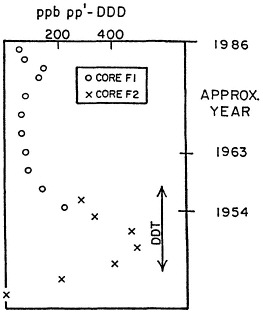
FIGURE 5.6 A chronology of pp'-DDD levels in Newark Bay sediments. Maximum levels in the late 1940s to early 1950s have been associated with the operation of a DDT manufacturing facility. This input could provide an excellent tracer of particle and associated contaminant movement in this estuary. (Source: Bopp et al., 1991)
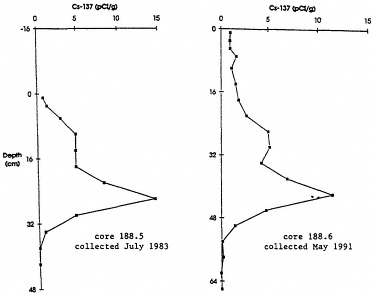
FIGURE 5.7 Depth profiles of Cs-137 activities in sediment cores collected at the same site in the upper Hudson River. The profiles indicate that samples from the two cores can be paired off. The same samples from the more recent core will represent an eight-year in situ incubation. Such samples could be quite useful in studies of in situ degradation of organic contaminants. Reprinted with permission from American Chemical Society, 1991.
TABLE 5.2 Levels of pp'-DDD and-chlordane on suspended particle samples from Newark Bay near the downstream end of the Hackensack River and the upper Hackensack River. The distinctive signatures suggest significant potential for tracing particles and associated contaminant mixing in the tidal reach of the Hackensack.
|
|
pp'-DDD (ppb) |
a-chlordane (ppb) |
pp'-DDD a-chl |
|
NEWARK BAY |
|||
|
F1049 4/26/85 |
112 |
35 |
3.2 |
|
F1054 8/20/85 |
110 |
29 |
3.8 |
|
F1077 |
103 |
37 |
2.8 |
|
Upper Hackensack River |
|||
|
F1051 4/26/85 |
61 |
116 |
0.53 |
|
F1052 7/30/85 |
48 |
111 |
0.43 |
|
F1075 3/11/86 |
55 |
84 |
0.65 |
We strongly suggest the archiving of sediment core samples for application in this type of study and for future use in other investigations.
Nutrients
There is a need for greater commitment to long-term, research-based monitoring and coordination of efforts. For the Hudson, agencies including the Interstate Sanitation Commission and the New York City Department of Environmental Conservation have collected historical monitoring data. Researchers at the Lamont-Doherty Geological Observatory and the Institute for Ecosystems Studies have worked on nutrient dynamics. The USGS National Water Quality Assessment program on the Hudson will include nutrient monitoring, and the Harbor Estuary Program is considering historical nutrient data and future research directions.
Wastewater discharge plays a major role in determining the levels of nutrients in Hudson estuary waters. Major impacts on the nutrient dynamics of the estuary would be expected as the result of New York's ban on phosphates in detergents and improvements in sewage treatment over the past two decades. Figure 5.8 summarizes what we consider to be the best data available for quantifying the
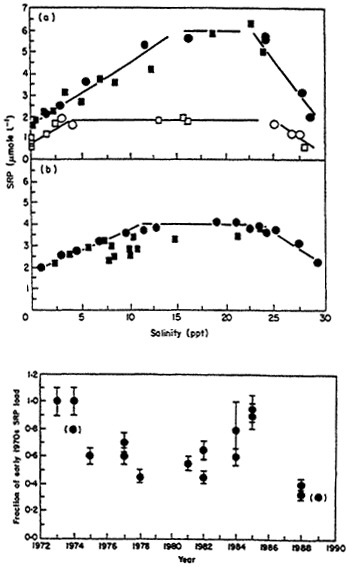
FIGURE 5.8 Plots of soluble reactive phosphate (SRP) versus salinity for the lower Hudson River. Many transects show the major input at mid salinities associated with New York Metropolitan Area wastewater discharge and quasi-conservative mixing with coastal ocean and fresh water endmembers. Panel ''a'' is from the mid-1970s. Solid symbols represent a period of low fresh water discharge (summer). Open symbols show the effects of high spring discharge flushing the estuary. Panel "b" represents a low-flow transect from 1988. The lower peak levels of SRP compared with those in the late 1970s reflect the effect of New York's ban on phosphate-based detergents and upgrades in Metropolitan Area sewage treatment. The lower panel shows the history of SRP loading to New York Harbor, derived from modeling similar transects. The general decrease in loading with time is interrupted by higher loadings in the mid-1980s that could be associated with reconstruction of primary clarifiers at a major sewage treatment plant. (Source: Clark et al., 1992a) Reprinted with permission from Academic Press Ltd, London, England, 1992.
changes in phosphate levels. The 15 years of collecting data were accomplished not as a result of any long-term funding initiative but rather through the creative use of piecemeal funding. This situation underscores the need for long-term funding commitments and coordination of efforts.
RESEARCH AND REGULATION-DRIVEN MONITORING
There seems to be significant and largely untapped potential for collaboration between research scientists and agencies involved in monitoring programs. For example, the New York City Department of Environmental Protection has regular cruises on the lower Hudson for the purpose of collecting water column and sediment-monitoring data. Participation of research scientists would make more efficient use of the ship time, broaden the data base, and help with data interpretation. For New York Harbor, sewage-treatment-plant effluent is an important source of contaminants, including trace metals and PCBs. Despite national focus on the Hudson River PCB problem, monitoring efforts have produced little useful quantitative data on the magnitude of this PCB source. A research-based approach, with modifications for the sampling, cleanup, and analytical procedures, could supply much-needed information on a limited set of samples. By necessity, this would be a joint effort involving cooperation between research scientists and the regulatory agencies.
Future use of filled wetlands bordering rivers and estuaries is an area with great potential for combining research and regulation-driven monitoring. The metropolitan region at the terminus of the Hudson is situated above groundwater aquifers of the Atlantic Coastal Plain and of more recent glacial origin. The character of the area is strongly urban and land usage has led to degradation of groundwater resources. An important source of pollutants in these aquifers is landfills. Formal strategies of wetland filling with solid waste have resulted in the eradication of most of the wetlands in the lower Hudson region, including over 45,000 acres in New York City (Walsh, 1991a). These landfills cover over 20 percent of the city's land area (Figure 5.9, Walsh, 1991b). Competition for real estate is great in this area and old landfills are in demand because they are often the only remaining large tracts of undeveloped land. Government regulations that require intensive environmental testing of such sites prior to development have led to numerous studies that yield information on aquifer geology and the quality of water, soil, and sediment. For example, environmental studies have recently been performed on eight lots on the north shore of Jamaica Bay ranging in size from 4 to 297 acres. The lots were part of a 6000-acre area of former tidal wetlands that were filled with solid wastes between 1910 and 1980 (Walsh, 1991a). The studies were all performed independently and, because of the narrow focus of each, a valuable opportunity to gain insight into the hydrologic and geochemical dynamics of this expansive landfill was lost. The importance of groundwater resources in densely populated coastal environments necessitates more effective coordination of future site investigations. If sufficient flexibility can be accommodated within the regulatory requirements, such investigations could form the basis of an important research effort on landfills and coastal aquifers.
OTHER SPECIFIC RESEARCH AREAS
Gas Exchange
Models of atmospheric oxygen inputs and nitrous oxide and organic contaminant export from estuaries generally relate turbulence to wind speed (Emerson, 1975), tidal flow (O'Connor and Dobbins, 1958), or the relatively few direct measurements that have been made. Recent work in lakes using injected tracers (Wanninkhof et al., 1985) shows great promise for direct determination of gas exchange. In the Hudson, injection of freons with sewage-treatment-plant effluent may provide a very useful gas-exchange tracer (Clark et al., 1992b; Figure 5.10).
Fine-Particle Behavior in the Coastal Environment
What is the fate of fine particles and associated contaminants flushed from estuaries during high-discharge events? What fraction is deposited on the shelf?. Is there significant transport to the deep ocean or onshore to estuaries and coastal bays? To what extent do estuaries act as particle traps? These basic and very significant questions are amenable to study with geochemical tracers. In the Savannah River estuary, (Olsen et al., 1989) utilized plutonium isotopic ratios and C-13 abundance in organic matter to study the importance of onshore particle transport, elaborating on an earlier study of Goldberg et al. (1979). In Baltimore Harbor, zinc and other trace elements were found to be effectively trapped by sedimentation, despite rapid flushing of the waters (Sinex and Helz, 1982). Some recent data on DDT-derived compounds in the coastal environment suggest that atmospheric inputs of unaltered DDT may provide a most useful tracer (Bopp et al., 1993; Table 5.3 and Figure 5.11).
CONCLUSIONS
Our observations on the Hudson indicate the need for attention to the basic monitoring data base, demonstrate that creative use of geochemical tracers should play an important role in future investigations, and suggest that coordination of research and monitoring efforts and continuity of research funding should be a high priority.
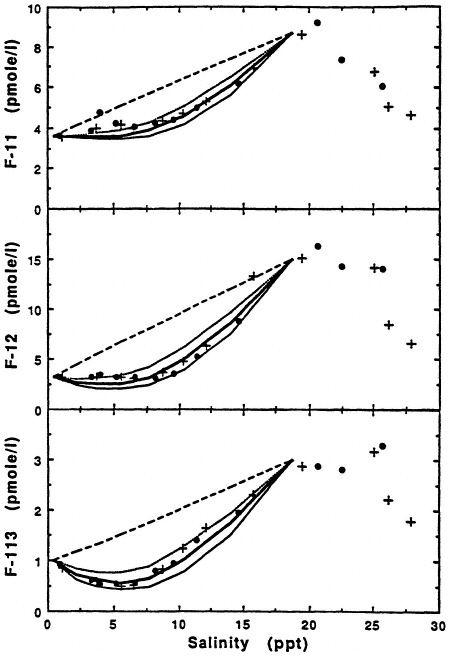
FIGURE 5.10 Levels of freons dissolved in Hudson River water plotted versus salinity. The mid-salinity peak has been associated with inputs from New York Metropolitan Area wastewater discharges into New York Harbor. The dashed line shows concentrations expected for conservative mixing between the harbor and the fresh water endmember. The data falls between model generated lines that allow for gas exchange at piston velocities of 1 and 4 cm/sec. (Source: Modified from Clark et al., 1992b)
TABLE 5.3 pp'-DDT to pp'-DDD ratios in samples from the Hudson estuary and samples from the continental slope, about 100 miles offshore. Lower rates in the estuary samples reflect anaerobic conversion of DDT to DDD. Much higher ratios in the offshore samples have been interpreted as the result of atmospheric inputs of fresh DDT.
|
|
pp'-DDT p'DDD |
|
ESTUARY SAMPLES |
|
|
Suspended Particles |
0.11-0.63 |
|
Sediment Cores |
0.05-0.87 |
|
Sewage Samples |
0.2-0.3 |
|
SLOPE SAMPLES |
|
|
Aerobic Sediments |
13-24 |
|
Trap Samples |
1.6-5.4 |
REFERENCES
Alderton, D. H. M. 1985. Sediments, p. 1-95 in Historical Monitoring, MARC Report Number 31, Monitoring and Assessment Research Centre, London, U.K., 320 pp.
Arnold, C. L. 1982. Modes of fine-grained suspended sediment occurrence in the Hudson River Estuary. M.S. Thesis, State University of New York, Stony Brook, New York.
Bishop, J. K. B., D. Schupack, R. M. Sherrell, and M. Conte. 1985. A multiple-unit large-volume in situ filtration system for sampling oceanic particulate matter in mesoscale environments, p. 155-175 in A. Zirino (ed), Mapping Strategies in Chemical Oceanography, American Chemical Society, Advances in Chemistry 209.
Bopp, R. F., H. J.Simpson, C. R. Olsen, R. M. Trier, and N. Kostyk. 1982. Chlorinated hydrocarbons and radionuclide chronologies in sediments of the Hudson River and estuary, New York, Environ. Sci. Technol., v. 16, p. 666-676
Bopp, R. F., H. J. Simpson, and B. L. Deck. 1985. Release of Polychlorinated Biphenyls from Contaminated Hudson River Sediments, Final Report NYS C00708, New York State Department of Environmental Conservation, Albany, NY, 89 pp.
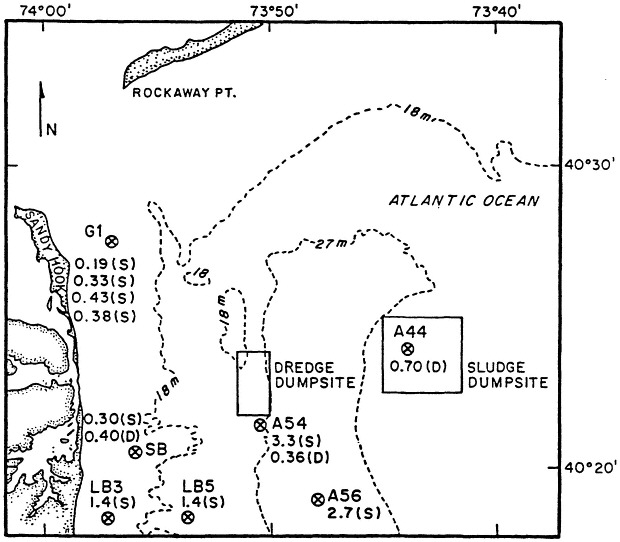
FIGURE 5.11 pp'-DDD to pp'-DDD ratios in surface (S) and deep (D) suspended particles from the coastal ocean near the mouth of the Hudson. Samples with ratios less than unity primarily reflect the influence of Hudson discharge (sites G1 and SB) or resuspension of bottom sediments (A54(D)). Samples with ratios greater than one suggestsignificant influence of atmospheric inputs of unaltered DDT. (Source: Bopp et al., 1993)
Bopp, R. F., and H. J. Simpson. 1989. Contamination of the Hudson River: the sediment record, p. 401-416 in Contaminated Marine Sediments: Assessment and Remediation, Washington, D.C.: National Academy Press.
Bopp, R. F., M. L. Gross, H. Tong, H. J. Simpson, B. L. Deck, and F. C. Moser. 1991a. A major incident of dioxin contamination: sediments of New Jersey estuaries, Environ. Sci. Technol., v. 25, p. 951-956.
Bopp, R. F., H. J. Simpson, D. W. Robinson, S. N. Chillrud, and A. Virgilio. 1991b. Chronologies of persistent contaminants in New York Harbor, Raritan Bay and Jamaica Bay, Abstract, Estuarine Research Federation Conference, San Francisco, CA, Nov. 10-14, 1991.
Bopp, R. F., D. W. Robinson, H. J. Simpson, P. E. Biscaye, R. F. Anderson, H. Tong, S. J. Monson, and M. L. Gross. 1993. Recent sediment and contaminant distributions in the Hudson Shelf Valley, 12-MDS Symposium Volume, NOAA Tech. Mem., in press. Ann Studholme, Editor. NOAA National Marine Fisheries in Sandy Hook, NJ.
Brown, J. F. Jr., R. E. Wagner, D. L. Beddard, M. J. Brennan, J. C. Carnahan, and R. J. May. 1984. PCB transformations in upper Hudson sediments, Northeastern Env. Sci. 3:167-179.
Clark, J. F., H. J. Simpson, R. F. Bopp, and B. L. Deck. 1992a. Geochemistry and loading history of phosphate and silicate in the Hudson estuary, Estuarine, Coastal and Shelf Science 34:213-233.
Clark, J. F., H. J. Simpson, W. M. Smethie, Jr., and C. Toles. 1992b. Gas exchange in a contaminated estuary inferred from chlorofluorocarbons, Geophys. Res. Lett. 19:1133-1136.
Emerson, S. 1975. Gas exchange rates in small Canadian sheild lakes, Limnol. Oceanogr. 20:754-761.
Findlay, S., M. Pace, and D. Lints. 1991. Variability and transport of suspended sediment, particulate and dissolved organic carbon in the tidal and freshwater Hudson River, Biogeochemistry 12:149-169.
Goldberg, E. D. 1976. Pollution history of estuarine sediments, Oceanus 19:18-26.
Goldberg, E. D., E. Gamble, J. J. Griffin, and M. Koide. 1977. Pollution history of Narragansett Bay as recorded in its sediments, Estuarine Coastal Mar. Sci. 5:549-561.
Goldberg, E. D., V. Hodge, M. Koide, J. Griffin, E. Gamble, O. P. Bricker, G. Matisoff, G. R. Holdten, Jr., and R. Braun. 1978. A Pollution History of Chesapeake Bay, Geochim. Cosmochim. Acta, 42:1413-1425.
Goldberg, E. D., V. F. Hodge, J. J. Griffin, M. Koide, and H. Windom. 1979. Pollution history of the Savannah River estuary, Environ. Sci. Technol. 13:588-594.
O'Connor, D. J., and W. E. Dobbins. 1958. Mechanism of reaeration in natural steams, Am. Soc. Civ. Eng., 123:641-694.
Olsen, C. R. 1979. Radionuclides, sedimentation and the accumulation of pollutants in the Hudson estuary. Ph.D. thesis, Columbia University, New York, NY.
Olsen, C. R., M. Thein, I. L. Larsen, P. D. Lowry, P. J. Mulholland, N. H. Cutshall, J. T. Bird and H. L. Windom. 1989. Plutonium, lead-210, and carbon isotopes in the Savannah estuary: riverborne versus marine sources, Environ. Sci. Technol. 23:1475-1481.
Panuzio, F. L. 1965. Lower Hudson River siltation, p. 512-560 in Proceedings of the Federal InterAgency Sedimentation Conference, 1963; Agricultural Research Service Misc. Publ. No. 970.
Sinex, S. A., and G. R. Helz. 1982. Entrapment of zinc and other trace elements in a rapidly flushed industrialized harbor, Environ. Sci. Technol., 16:820-825.
Suszkowski, D. J. 1978. Sedimentology of Newark Bay, New Jersey: an urban estuary. Ph.D. Thesis, University of Delaware, Newark, Delaware.
U.S.Geological Survey. 1984. Water Resources Data for New York, Water Year 1983, USGS Water Data Report NY-83-1. Washington, D.C: U.S. Government Printing Office.
Walsh, D. C. 1991a. The history of waste landfilling in New York City, Ground Water 29:591-3.
Walsh, D. C. 1991b. Reconnaissance mapping of land fills in New York City, in Proceedings of FOCUS Conference on Eastern Regional Ground Water Issues, National Ground Water Association, Portland, ME, October 29-31, 1991 .
Wanninkhof, R., J. R. Ledwell, and W. S. Broecker. 1985. Gas exchange-wind speed relation measured with sulfur hexafluoride on a lake, Science 27:1224-1226.

